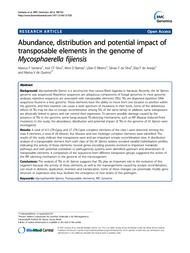Abundance, distribution and potential impact of transposable elements in the genome of Mycosphaerella fijiensis.
Abundance, distribution and potential impact of transposable elements in the genome of Mycosphaerella fijiensis.
Summary: Mycosphaerella fijiensis is a ascomycete that causes Black Sigatoka in bananas. Recently, the M. fijiensis genome was sequenced. Repetitive sequences are ubiquitous components of fungal genomes. In most genomic analyses, repetitive sequences are associated withtransposable elements (TEs). TEs are dispersed repetitive DNA sequences found in a host genome. These elements have the ability to move from one location to another within the genome, and their insertion can cause a wide spectrum of mutations in their hosts. Some of the deleterious effects of TEs may be due to ectopic recombination among TEs of the same family. In addition, some transposons are physically linked to genes and can control their expression. To prevent possible damage caused by the presence of TEs in the genome, some fungi possess TE-silencing mechanisms, such as RIP (Repeat Induced Point mutation). In this study, the abundance, distribution and potential impact of TEs in the genome of M. fijiensis were investigated.
Publication year: 2012
Types of publication: Journal article
Unit: Embrapa Western Amazon
Keywords: Mycosphaerella Fijiensis, RIP, Transposable elements, genome
Observation
Some of Embrapa's publications are published as ePub files. To read them, use or download one of the following free software options to your computer or mobile device. Android: Google Play Books; IOS: iBooks; Windows and Linux: Calibre.
Access other publications
Access the Agricultural Research Database (BDPA) to consult Embrapa's full library collection and records.
Visit Embrapa Bookstore to purchase books and other publications sold by Embrapa.

